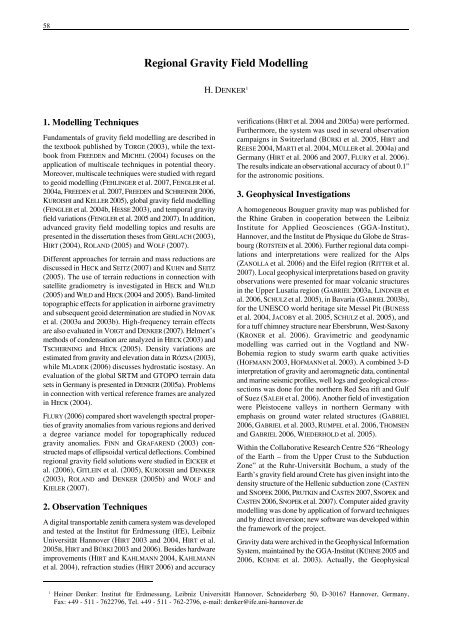NATIONAL REPORT OF THE FEDERAL REPUBLIC OF ... - IAG Office
NATIONAL REPORT OF THE FEDERAL REPUBLIC OF ... - IAG Office
NATIONAL REPORT OF THE FEDERAL REPUBLIC OF ... - IAG Office
You also want an ePaper? Increase the reach of your titles
YUMPU automatically turns print PDFs into web optimized ePapers that Google loves.
58<br />
1. Modelling Techniques<br />
Fundamentals of gravity field modelling are described in<br />
the textbook published by TORGE (2003), while the textbook<br />
from FREEDEN and MICHEL (2004) focuses on the<br />
application of multiscale techniques in potential theory.<br />
Moreover, multiscale techniques were studied with regard<br />
to geoid modelling (FEHLINGER et al. 2007, FENGLER et al.<br />
2004a, FREEDEN et al. 2007, FREEDEN and SCHREINER 2006,<br />
KUROISHI and KELLER 2005), global gravity field modelling<br />
(FENGLER et al. 2004b, HESSE 2003), and temporal gravity<br />
field variations (FENGLER et al. 2005 and 2007). In addition,<br />
advanced gravity field modelling topics and results are<br />
presented in the dissertation theses from GERLACH (2003),<br />
HIRT (2004), ROLAND (2005) and WOLF (2007).<br />
Different approaches for terrain and mass reductions are<br />
discussed in HECK and SEITZ (2007) and KUHN and SEITZ<br />
(2005). The use of terrain reductions in connection with<br />
satellite gradiometry is investigated in HECK and WILD<br />
(2005) and WILD and HECK (2004 and 2005). Band-limited<br />
topographic effects for application in airborne gravimetry<br />
and subsequent geoid determination are studied in NOVAK<br />
et al. (2003a and 2003b). High-frequency terrain effects<br />
are also evaluated in VOIGT and DENKER (2007). Helmert’s<br />
methods of condensation are analyzed in HECK (2003) and<br />
TSCHERNING and HECK (2005). Density variations are<br />
estimated from gravity and elevation data in RÓZSA (2003),<br />
while MLADEK (2006) discusses hydrostatic isostasy. An<br />
evaluation of the global SRTM and GTOPO terrain data<br />
sets in Germany is presented in DENKER (2005a). Problems<br />
in connection with vertical reference frames are analyzed<br />
in HECK (2004).<br />
FLURY (2006) compared short wavelength spectral properties<br />
of gravity anomalies from various regions and derived<br />
a degree variance model for topographically reduced<br />
gravity anomalies. FINN and GRAFAREND (2003) constructed<br />
maps of ellipsoidal vertical deflections. Combined<br />
regional gravity field solutions were studied in EICKER et<br />
al. (2006), GITLEIN et al. (2005), KUROISHI and DENKER<br />
(2003), ROLAND and DENKER (2005b) and WOLF and<br />
KIELER (2007).<br />
2. Observation Techniques<br />
A digital transportable zenith camera system was developed<br />
and tested at the Institut für Erdmessung (IfE), Leibniz<br />
Universität Hannover (HIRT 2003 and 2004, HIRT et al.<br />
2005B, HIRT and BÜRKI 2003 and 2006). Besides hardware<br />
improvements (HIRT and KAHLMANN 2004, KAHLMANN<br />
et al. 2004), refraction studies (HIRT 2006) and accuracy<br />
Regional Gravity Field Modelling<br />
H. DENKER 1<br />
verifications (HIRT et al. 2004 and 2005a) were performed.<br />
Furthermore, the system was used in several observation<br />
campaigns in Switzerland (BÜRKI et al. 2005, HIRT and<br />
REESE 2004, MARTI et al. 2004, MÜLLER et al. 2004a) and<br />
Germany (HIRT et al. 2006 and 2007, FLURY et al. 2006).<br />
The results indicate an observational accuracy of about 0.1"<br />
for the astronomic positions.<br />
3. Geophysical Investigations<br />
A homogeneous Bouguer gravity map was published for<br />
the Rhine Graben in cooperation between the Leibniz<br />
Institute for Applied Geosciences (GGA-Institut),<br />
Hannover, and the Institut de Physique du Globe de Strasbourg<br />
(ROTSTEIN et al. 2006). Further regional data compilations<br />
and interpretations were realized for the Alps<br />
(ZANOLLA et al. 2006) and the Eifel region (RITTER et al.<br />
2007). Local geophysical interpretations based on gravity<br />
observations were presented for maar volcanic structures<br />
in the Upper Lusatia region (GABRIEL 2003a, LINDNER et<br />
al. 2006, SCHULZ et al. 2005), in Bavaria (GABRIEL 2003b),<br />
for the UNESCO world heritage site Messel Pit (BUNESS<br />
et al. 2004, JACOBY et al. 2005, SCHULZ et al. 2005), and<br />
for a tuff chimney structure near Ebersbrunn, West-Saxony<br />
(KRONER et al. 2006). Gravimetric and geodynamic<br />
modelling was carried out in the Vogtland and NW-<br />
Bohemia region to study swarm earth quake activities<br />
(H<strong>OF</strong>MANN 2003, H<strong>OF</strong>MANN et al. 2003). A combined 3-D<br />
interpretation of gravity and aeromagnetic data, continental<br />
and marine seismic profiles, well logs and geological crosssections<br />
was done for the northern Red Sea rift and Gulf<br />
of Suez (SALEH et al. 2006). Another field of investigation<br />
were Pleistocene valleys in northern Germany with<br />
emphasis on ground water related structures (GABRIEL<br />
2006, GABRIEL et al. 2003, RUMPEL et al. 2006, THOMSEN<br />
and GABRIEL 2006, WIEDERHOLD et al. 2005).<br />
Within the Collaborative Research Centre 526 “Rheology<br />
of the Earth – from the Upper Crust to the Subduction<br />
Zone” at the Ruhr-Universität Bochum, a study of the<br />
Earth’s gravity field around Crete has given insight into the<br />
density structure of the Hellenic subduction zone (CASTEN<br />
and SNOPEK 2006, PRUTKIN and CASTEN 2007, SNOPEK and<br />
CASTEN 2006, SNOPEK et al. 2007). Computer aided gravity<br />
modelling was done by application of forward techniques<br />
and by direct inversion; new software was developed within<br />
the framework of the project.<br />
Gravity data were archived in the Geophysical Information<br />
System, maintained by the GGA-Institut (KÜHNE 2005 and<br />
2006, KÜHNE et al. 2003). Actually, the Geophysical<br />
1 Heiner Denker: Institut für Erdmessung, Leibniz Universität Hannover, Schneiderberg 50, D-30167 Hannover, Germany,<br />
Fax: +49 - 511 - 7622796, Tel. +49 - 511 - 762-2796, e-mail: denker@ife.uni-hannover.de











